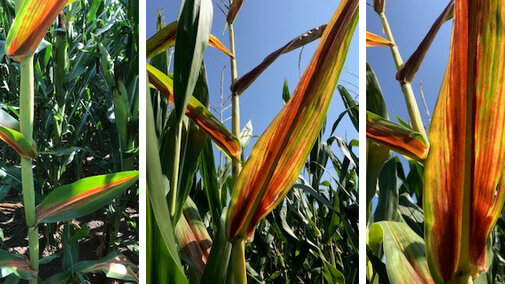I have red leaves and stalks on isolated corn plants. What is going on?
The red to purplish tint in corn late in the season results from an overabundance of photosynthetic sugars in the stalk and leaves. Sugar was produced by photosynthesis, but the plant had few or no kernels in which to move the sugar. Essentially, there was a sink-source imbalance in the plant.
What caused the red pigment in the leaves?
The red pigment could be caused by a variety of stresses, but it all goes back to the developing kernels and ear. Temperature, water, or disease stress during or just before pollination could affect kernel set and the developing ear. During pollination, throughout northeast Nebraska, high temperatures and high humidity occurred during the critical stages of tasseling and silking. These stresses can affect kernel set negatively. (See Tom Hoegemeyer’s CropWatch article on how high temperatures and humidity can affect pollination.) With few or no developing kernels, the corn plant had no sink to move the sugar to. Sink organs are photosynthetically inactive and source organs are photosynthetically active. In the case of corn, source organs (leaves) assimilate sugars and move them to the sink organs (kernels) to be stored.
Should I be concerned?
Unfortunately, there is no way to treat red corn and typically the pigmentation will persist throughout the season. This red coloring serves as a red flag when it comes to the production of that particular plant, indicating that yield will be low or none at all. This is typically an isolated issue on end rows or in small pockets within a field so may not affected yield greatly.
References
Dixon, Richard A. and Nancy L. Paiva. 1995. Stress-lnduced Phenylpropanoid Metabolism. The Plant Cell 7:1085-1097. American Society of Plant Physiologists.
Seebauer, J. R., Singletary, G. W., Krumpelman, P. M., Ruffo, M. L., and Below, F. E. 2010. Relationship of source and sink in determining kernel composition of maize. Journal of Experimental Botany. 61:511–519.

